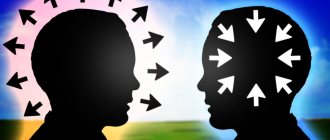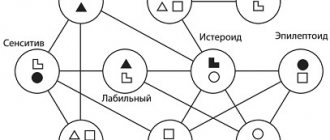Definition of character
The ancient Greek scientist Theophrastus studied character and introduced this term into science. He believed that this definition should reflect the traits, characteristics, signs and characteristics of a person. Aristotle understood character as a definition of a person's actions; he used such a concept as ethos
(Greek ἦθος), denoting disposition, mental disposition. Translated from ancient Greek, character (χαρακτήρ) is a distinctive feature. When speaking about the nature of any person, they mean the totality of qualities of manners, lifestyle, mental and general state. In the history of the study of this concept, different definitions have been derived.
Mark Samuilovich Lebedinsky and Vladimir Nikolaevich Myasishchev defined character in mental individuality, expressed in peculiar behavior, formed on the basis of temperament and behavior of the individual. Konstantin Konstantinovich Platonov considered character to be a set of stable traits expressed in actions and actions. The Soviet psychologist, Konstantin Nikolaevich Kornilov, saw character in personality traits, manifested in an expressed worldview, moral beliefs, ideals, and interests.
Character is manifested in activity, communication, reveals behavior and specific features, shades. Some people enjoy challenging activities and enjoy overcoming obstacles. Others choose simpler work and try to avoid problems. For some, the importance of the work performed and the result obtained, which should be the best, is important, others may treat the work carelessly and will be satisfied that they are coping with responsibilities no worse than others. All this characterizes differences in the natures of people.
So, what does such a concept as character mean? These are the combined traits of a certain personality, expressed in actions or behavior in relation to people, activities, events happening around
. Everyone’s character is unique and manifests itself in communication, behavior, socio-psychological, moral, spiritual worldview and actions.
We can say that in society there is a division into people with strong and weak character. A person with a strong nature behaves persistently, persistently, and purposefully. A weak-willed person exhibits weakness, unpredictability, and imbalance. The task in studying the structure of character should determine its traits, manifestations, and their interrelationship.
Character is closely intertwined with will and temperament. Gordon Allport also noted that temperament and character look like synonyms and are intended for the individual. He noted that speaking about a person with good character implies an assessment of the individual, and not social and ethical qualities. Therefore, the concept has an evaluative image. Allport presented temperament as the primary material, the constitution of the intellect, and the characteristics of genetics.
Basic character properties in psychology
Nbsp; REPORT ON THE SUBJECT OF PSYCHOLOGY ON THE TOPIC: “CHARACTER” Prepared by: Andreeva V.O. Mikhailova O.V. Nefedova L.N. 2018
Definition of "Character"
In psychology, the concept of character (from the Greek character - “seal”, “minting”) means a set of stable individual characteristics of a person that develop and manifest themselves in activity and communication, determining the typical modes of behavior for it. This is the invisible core of our psyche, on which other properties and personality traits are strung
A person’s character is what determines his significant actions, and not random reactions to certain stimuli or prevailing circumstances. The action of a person with character is almost always conscious and deliberate, and can be explained and justified, at least from the position of the actor. When talking about character, we usually put into our idea of it a person’s ability to behave independently, consistently, regardless of circumstances, showing his will and perseverance, determination and perseverance. A characterless person in this sense is one who does not show such qualities either in activity or in communication with people, goes with the flow, is dependent on circumstances, and is controlled by them.
Character is the framework of personality, which includes only the most pronounced and closely interrelated personality traits, clearly manifested in various types of activities.
Character is an individual combination of the most stable, significant personality traits, manifested in human behavior in a certain respect.
In the system of personality relationships, four groups of character traits are distinguished:
| GROUPS OF TRAITS | POSITIVE CHARACTER TRAITS | NEGATIVE CHARACTER TRAITS |
| ATTITUDE TOWARDS OTHER PEOPLE | Sociability, sensitivity, responsiveness, respect for other people. | Closedness, callousness, rudeness, contempt for people. |
| ATTITUDE TO WORK | Hard work, accuracy, creativity, conscientiousness in work, responsible attitude to work, initiative, perseverance. | Laziness, tendency to routine work, dishonesty in doing work, irresponsible attitude to work, passivity. |
| ATTITUDE TO YOURSELF | Self-esteem, sense of honor, self-criticism, modesty. | Conceit (sometimes turning into arrogance), vanity, arrogance, touchiness, shyness, egocentrism (as a tendency to consider oneself and one’s experiences at the center of events), selfishness. |
| ATTITUDE TO THINGS | Neatness, careful handling of things. | Sloppiness, careless handling of things. |
Types of character
The conditions of the surrounding reality play an important role in the formation of specific behavioral stereotypes and lifestyles. In different social groups, certain character traits and types of personality orientation develop. The more favorable the opportunities, the higher the level of character development. The formation of the best character traits occurs with a high moral and cultural education of the environment.
Excessive development of any individual traits is called accentuation. Based on behavioral characteristics, from a psychological point of view, people are usually divided into introverts (closed) and extroverts (sociable). There are also types of character classified by accentuation:
- Hyperthymic. It includes people who are sociable, talkative, and have developed facial expressions. They are also characterized by irritability and frivolity. They have a high level of energy and initiative.
- Disthymic . Determines the character of a person with a pessimistic orientation and isolation. Such people feel uncomfortable in large companies and avoid crowded places. Friends are an authority, the sense of justice is heightened. They are slow when it comes to making an important decision.
- Cycloid. The mood often changes; they can be either overly sociable or overly withdrawn.
- Excitable. Very conflicted people. They show authority in the family and have poor relationships with colleagues. They are attentive and careful if they are in a state of apathy. Very irritable and quick-tempered if the mood is bad.
- Stuck. True provocateurs are intractable, too demanding of both themselves and others.
- Pedantic. With this type of character, a pathological craving to notice little things is revealed.
- Anxious. Characteristic of insecure individuals, absolutely conflict-free and weak-willed. They always try to find support from others, are overly self-critical, but friendly.
- Demonstrative . Self-confident, conflict-ridden, bright intriguers. Adapts well to any conditions. They have artistry and extraordinary thinking, but at the same time they are hypocritical and selfish.
Dominant spiritual or material needs have a direct impact on changing character traits. Deep and lasting interests are based on the self-sufficiency of the individual. An insecure person rarely has meaningful and deep behavioral principles. Such individuals often change their minds.
In modern psychological literature you can find several classifications of character types. Among the many criteria by which character type is determined, classification by body type is especially popular. Its author is a scientist-psychologist, researched by E. Kretschmer. The division occurs into three groups:
1. 1. Picnic people constitute a group of overweight or obese individuals. Their main traits are kindness, responsiveness, the ability to empathize and help loved ones. They are emotional, sociable, and cope well with complex tasks. Balanced and tactful in communicating with others of any age.
2. 2. Athletic people are tall, have a wide chest and well-developed muscles. Powerful and reserved. They hide their feelings from others and do not allow interference in their personal lives. They adapt poorly to new conditions, are practical, unimpressive, stingy with compliments and pleasant words.
3. 3. Asthenic people are thin with poorly developed muscles and an elongated face. Serious, reserved and stubborn individuals. With a negative attitude towards change and innovation. They prefer loneliness to noisy companies. They have a high degree of anxiety, are stubborn, and selfish.
And as it was already said above that character changes throughout life’s journey, it can be noted that with age a person’s character can change. In the period of 20-30 years, experiences occur regarding the creation of a family and the birth of children. The state of falling in love, establishing new connections at work and in a group of friends prevail over others. At the age of 30-40, most people are obsessed with plans and goals for the future. All active activities are aimed precisely at the implementation of the plan.
Upon reaching 50 years of age, the attention of each individual is focused on assessing what has been achieved during his life. Individual properties change, wisdom, measuredness, and tolerance come. After 60 years, most people begin to worry about the years they have lived. I constantly want to be nostalgic and not think about the future. Driven character traits: regularity, slowness, tranquility.
CHARACTER PROPERTIES.
The wise Victor Hugo believed that each of us has three characters at once, one we attribute to ourselves, the second is ascribed to us by people who know us, and only the third is true. A person’s character traits shape both his personality and his life as a whole, you can’t argue with that. That is why this topic is so carefully studied by psychologists and psychotherapists around the world.
Basic character properties in psychology
- strength is a very important component of character, because a person with a strong character will survive at all costs, will be able to become a leader, carry out his plans, and successfully overcome obstacles;
- weakness manifests itself in a completely different way - a person with a weak character gives up without a fight, he is characterized by cowardice, indecision and even cowardice;
- curiosity is an important character trait, because it forces you to study, learn more, and receive new information;
- integrity of character is another most important property; in fact, it is simply the consistency of principles, relationships, and actions of an individual in different aspects of life;
- originality - it manifests itself in the uniqueness, unusualness of a person, the originality of his tastes and opinions;
- firmness - this character trait is manifested by perseverance, persistence, consistency, constancy of views and opinions.
There is another classification that provides 4 main character traits:
Emotional (cheerfulness, balance, cheerfulness, etc.)
Volitional (self-control, desire to achieve success)
Intellectual (judgment, observation, thoughtfulness)
Moral (responsibility, justice, kindness). —
It is extremely important to remember that personality traits are not constant factors; they can change, disappear and appear. The necessary properties can be cultivated in oneself, and the ones that interfere with them can be gotten rid of through an effort of will.
Character diagnostic methods
Character traits
The important elements that make up the essence of character are its traits. Some come to us at birth, some are acquired during life. The list and structure of character traits are so wide that they constitute a whole system of psychological concepts. Psychologist Gordon Allport defined his type of behavior in all manifestations as a character trait of a certain personality and divided it into three categories:
- The main distinguishing features that shape personality, determine a person’s activity and attitude to the universe.
- Common traits manifest themselves in all areas of life as humanity and honesty.
- Additional, secondary, dependent on the main and ordinary ones are not actively manifested, for example, love for music and poetry.
People have many different character traits. They can be classified and divided into the following groups:
- Strong-willed
. Reflects ongoing events related to a person’s will, attention to oneself, and manifests itself in selfishness, criticality, modesty, demandingness, and self-sufficiency. - Communicative
. Expressed in mutual communication, in rude or polite form, in honesty or lies, in openness or isolation. - Business
. Characterizes hard work, reflected in activity or passivity, desire for work or idleness, formality or guarantee. - Motivational
. Encourages movement, activity with the universe, manifests itself in conscientiousness or negligence, worry and apathy.
Another classification has been formed that systematizes character traits according to their qualities:
- Intellectuals
are characterized by such traits as a desire to study, cunning, thoughtfulness, and quick wit. - Moral
values include kindness, toughness, honesty, and responsiveness. - Strong-willed ones
include categoricalness, willpower, independence, and confidence. - Emotional
characterizes cheerfulness, emotions, impressionability.
The main events in creating an image will be the relationships between people and in society. It is possible to determine the image of a person outside of a public association, without comradely contacts, friendship and love. A person individually creates a direction of organizational principles by studying various situations, comparing alternative combinations of moves. It is essential when analyzing your actions to compare them with the actions of other people. In this case, the appearance of the individual is revealed with his perseverance and flexibility, with courage and tolerance.
Strong-willed character traits in a person differ in the breadth of his views and diversity of possession of volitional qualities, the power of nature and movements, the desire to overcome difficulties, restraint in expression, and dynamism in different areas. Emotional, involuntary reactions of the individual to methods of rewarding or dissatisfying one’s desires are expressed in direct neuropsychic and irritating manifestations of the condition.
The statement: “I have such a character, I can’t help it,” is considered untenable in terms of the development of psychology. Any individual is responsible for all manifestations of his appearance, and can change his essential features. Remaking or changing character is not an easy matter. The main obstacle on this path is one of the most insidious traits - laziness. Having recognized themselves as lazy, many people think that this vice is like a screen hiding some advantages and make a value out of it. The fact is that laziness is a trait of nature that indicates mental weakness and powerlessness; under this mask bad deeds are committed and indifference and weakness appear. Having overcome laziness, a person is able to cope with difficulties and develop a strong character.
Character types
Since ancient times, many have tried to model the typology of characters. The earliest scheme was presented by the German psychiatrist Ernst Kretschmer, and another attempt was made by the American psychologist William Herbert Sheldon. At a later time, work was carried out by scientists Erich Fromm, Karl Leonhard, Andrei Evgenievich Lichko. The work was based on the following basic ideas:
- People united by typology must be divided into group formations.
- The formation of the image occurs from the beginning of birth and stability strengthens with age.
According to E. Kretschmer’s classification, personality traits are not chaotic; they are united by typology and divided into certain types:
- Picnic type
. A man of average height, with a short neck. Has a predisposition to mental disorders, underdeveloped muscles, obesity, overweight. - Athletic type
. Belongs to a group of developed, strong, strong-willed people. Short, well-muscled, broad chest and shoulders. - Asthenic type
. They have a thin and emaciated structure and appear taller than they actually are. The skin is delicate, the shoulders are not wide, the chest is elongated, thin arms, there is practically no fat in the body. This characteristic applies more to asthenic men. And women, moreover, are also short. - Dysplastic type
. Has characteristics with elements that are contradictory and inharmonious in the structure of the body for a person; this qualification is the opposite of the three presented above.
Psychiatrists highly assessed and studied the structure of concepts according to the type and characteristics of the participants tested, and used special tests and analysis methods. Their conclusions were repeatedly confirmed during subsequent inspections. For example, Leonhard presented a classification of accentuated traits, which are more often found in patients with neurosis. These include:
- Dysthymic type
. People with fairly low sociability are laconic and pessimistic. These are people who do not like noise and scandals and are considered homebodies. They are characterized by the traits of seriousness, conscientious attitude, and equality. - Hyperthymic type
. Those who like to express a unique type of character in emotional gestures and pantomime. They belong to the initiators of conflicts and react negatively to reproaches and remarks. - Pedantic type
. An interesting type, more like aristocrats and formalists. But he is considered thrifty, reliable, and respectable. - Cycloid type
. Has variability in mood, can be either closed or sociable, as they say: “a person of mood.” - Excitable type
. Hot-tempered, quarrelsome, has low sociability, a constant tendency to conflicts, rudeness and abuse. - Stuck type
. Loves to teach, moderately sociable, boring, can get offended, ambitious and jealous, demanding of his subordinates and himself. - Emotive type
. They have a closed, small social circle, keep all problems to themselves, have high sensitivity, are tearful, and are kind and compassionate by nature. - Anxious type
. Refers to timid, insecure individuals. They are friendly, love self-criticism, and are excellent performers. - Demonstrative type
. They can communicate freely, have elements of leadership and strive for power. Highly adaptable, prone to intrigue, sometimes annoying with self-confidence and close attention to oneself. They are artistic, think and act out of the ordinary. - Introverted type
. Philosophers are reserved, love solitude, have strong beliefs and certain principles, and are sometimes stubborn. - Extroverted type
. A person with a lot of acquaintances is always open and has access to any information. They are friendly, efficient, frivolous, and commit rash acts. - Exalted type
. They often argue, are deeply communicative, amorous, have attention to friends and loved ones, are often compassionate, and stand out for their vivid feelings and panicky behavior.
Character formation and development
Many people are interested in the problem of how and at what time does character change? Now scientists firmly know that the first characteristic features can be noticed in a child in early childhood, before school. With age, qualities and new traits are formed, and a full-fledged personality is developed. To raise a person with a strong nature, courageous and self-possessed, he should be introduced as a child to collective games according to strict rules and plots. To develop responsibility, it is necessary from childhood to set tasks from simple to more complex with discipline and endurance, to evaluate decisions and actions.
From a young age, kindness, sociability, responsiveness or, on the contrary, selfishness, callousness, and indifference are instilled. During school years, sociability prevails, strong-willed qualities and worldview are strengthened. Further, over the course of life, character traits change, a type is formed in new conditions, adapting to the prevailing circumstances. And by the age of 17, changes in personal characteristics become stable and have a certain form.
The folding and formation of the necessary qualities can be influenced by:
- Illness, change in lifestyle.
- Change, making friends.
- Crisis of the transition period in youth.
With age, childish traits weaken and more rational and responsible traits inherent in a person after 30 become stronger. In a later period, after 50 years, the period of the past and the future meet, the past is affirmed in the present, concern for health and well-being is uniform.
Bibliography
1. Vygotsky L.S. Pedagogical psychology. – L., 1983.
2. Enikeev M.I. General and legal psychology (in two parts). Part I “General psychology”. Textbook. – M.: Legal. lit., 1996.
3. Kovalev A.G., Myasishchev V.N. Psychological characteristics of a person. T. 1. Character. – L., Leningrad State University Publishing House, 1958.
4. Brief psychological dictionary / Ed. A.V. Petrovsky and M.G. Yaroshevsky. – M., 1985.
5. Krutetsky V.A. Psychology. – M.: Education, 1986.
6. Levitov N.D. Psychology of character. 3rd ed. – M., Education, 1964.
7. Leongard K. Accentuated personalities. – Kyiv, 1981.
8. Leontyev A.N. Problems of mental development. – M., 1965.
9. Lichko A.E. Psychopathy and character accentuations in adolescents. – L., 1983.
10. Nemov R.S. Psychology. – M.: Education, 1990.
11. Nemov R.S. General psychology: Textbook. for students education institutions prof. education. – M., 2003.
12. General psychology: Textbook for students of pedagogy. Institute / A.V. Petrovsky, A.V. Brushlinsky, V.P. Zinchenko and others; Ed. A.V. Petrovsky. – M.: Education, 1986.
Attention!
If you need help writing a paper, we recommend turning to professionals. More than 70,000 authors are ready to help you right now. Free adjustments and improvements. Find out the cost of your work
Free estimate
+1
Size: 24.82K
Downloads: 72
11/18/14 at 05:17 pm Author: Portugal
Liked? Click on the button below. It's not difficult for you
, and we
are pleased
).
To download Abstracts for free at maximum speed, register or log in to the site.
Important! All presented Abstracts for free downloading are intended for drawing up a plan or basis for your own scientific works.
Friends! You have a unique opportunity to help students just like you! If our site helped you find the job you need, then you certainly understand how the job you add can make the work of others easier.
Add a job
If, in your opinion, the Abstract is of poor quality, or you have already seen this work, please let us know.








